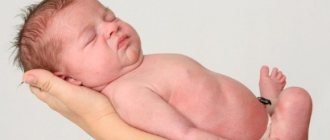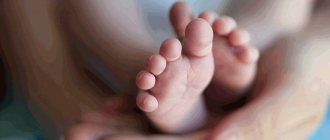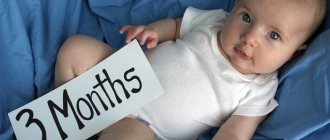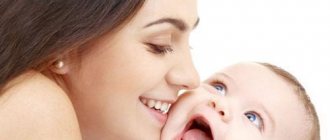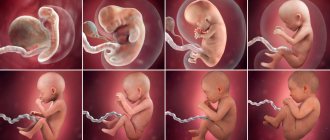Everyone can imagine in general terms what it means to care for a child, especially a newborn. Feed, wash, change, hold, entertain, wash, feed again, wash, change, rock, put to bed, change, feed, put to bed... and so on.
Developmental care offers to add additional, special meaning to every ordinary action and daily ritual of caring for a child.
Breastfeed knowing that you are giving the best not only for nutrition, but also for brain development and stimulation. Change clothes and hold in your arms, but in such a way as to allow the child’s small growing muscles to work, giving them a small feasible load. Wash and shake - only in the correct physiological position. Put them to bed - but in such a way as not to disturb the usual rhythm of life of the rest of the family. One of the advantages and distinctive features of developmental care methods is the inclusion of the child in the varied daily activities of adults.
What does a newborn baby need at home to sleep comfortably?
First, you need to decide in which room the child will sleep. In the first days of a baby's life at home, it is especially important that parents can quickly come when he calls them. For this reason, most moms and dads install a crib in their bedroom. In some families, a separate children's room is equipped in the house or apartment for a newborn, and communication with it is ensured using a baby monitor. This option has its advantages, for example, you do not have to compact the layout of the marital bedroom or give up the habit of sleeping with an open window. However, a baby monitor, like any household appliance, can fail unexpectedly, so it is important for you to make sure that you can hear your baby's cry even through the door.
If you think the room needs renovation, try to do it early. When a newborn baby is at home, there should be no smell of paints and varnishes, and some chemical odors can take weeks to dissipate. Construction dust is also harmful to the baby, as it is almost impossible to remove at one time, and may require two or three cleanings with a break of several days.
So, the room is ready. Now you need to find a place for the crib with an ideal microclimate - with good ventilation and lighting, but without drafts, direct sunlight and not near the battery. It is advisable that from the crib you can observe what is happening around - this way the baby will begin to explore the world immediately after the maternity hospital.
What else should be prepared at home for a newborn's sleep?
Blanket
Immediately after the maternity hospital, the baby will need a blanket, there should even be two of them - for warm and cold weather. However, you can do without blankets at all. Today, sleeping bags for infants are becoming increasingly popular. They do not restrict the baby's movement and are often all-weather: in winter the bag is used with sleeves, and in summer they are unfastened.
Bed sheets
The bedding essentials for a newborn at home are a sheet and a duvet cover, but if you plan to use a sleeping bag, you only need to buy sheets. On the baby’s first day at home, and even in the first year after the maternity hospital, the baby not only does not need a pillow, but is even harmful. While the baby's vertebrae are mobile, he must sleep on a flat surface, otherwise he risks getting a curvature of the spine. Also, the pillow can block the baby's airway, which is very dangerous. Accordingly, you don’t need to buy pillowcases yet.
The baby should have at least two sets of bed linen - he sleeps on one while the second is washed or dried. However, in case of unforeseen circumstances, it is better to have a small reserve.
Night light
A night light can come in handy if your baby is afraid to sleep without light, and this is a fairly common occurrence. Do not turn on the night light in the first days of the newborn at home; there is no need to specially teach the baby to sleep in the light. Only start using it if you notice that your baby is fussy and crying in the dark. This device can be purchased at a children's goods store, but any “adult” lamp with adjustable brightness will also work.
Thermometer
The temperature of the home for newborns should be maintained between 18–22 °C. It is difficult to estimate the temperature based on your own feelings, so buy a thermometer. He will give an exact answer to the question of what to do at the moment - heat the room or cool it. When the apartment is cool, use an electric heater; when it is hot, open the window or turn on the air conditioner. But if you feel that air currents are reaching the crib, you will have to abandon automatic air conditioning. Switch to manual mode: take the baby out of the room, cool it, turn off the air conditioner (close the window), bring the baby back, repeat as necessary.
It's even better if, in addition to the thermometer, you buy a hygrometer - a device that shows humidity. There are weather stations that combine both functions. Heating appliances dry out the air a lot, and this is not what is needed after the maternity hospital. To create a comfortable environment for your baby at home, buy an air humidifier or use traditional methods - a spray bottle, wet towels on a radiator, etc.
Brought it home and...
When you just arrive home from the hospital, undress your baby, change his diaper and put on clean home clothes. If the child is hungry, feed him. Pediatricians recommend breastfeeding on demand
- not according to a schedule, but when the baby is hungry and wants to eat. It is best to feed your baby while sitting, always with back support. This can be done in a chair or on a bed with pillows under your back. When the baby has eaten and falls asleep, go to rest yourself - your body still needs recovery after childbirth. “Besides, it is unknown how much sleep you will be able to sleep the next night,” notes Baibarina. It would be right if happy relatives do not organize a big feast at home. It is better to postpone congratulations to young parents for some time to allow the family and baby to adapt to the new life.
What is needed for bathing at home in the first days of a newborn’s life?
Bathing is a very important skin care procedure for your baby. Water washes away dirt and bacteria from your baby's body, reducing the risk of diaper rash. The baby needs to be bathed about 3 times a week. Therefore, before welcoming your newborn home, you must purchase everything necessary for water procedures.
Baby bath
Already on the baby’s first day at home, almost immediately after the maternity hospital, he will have to bathe, and for this he must have his own bath. The word “own” means that it is intended only for bathing the baby. Washing, folding dirty laundry and otherwise using the bath for other purposes is strictly prohibited.
It is advisable to think in advance where you will place the bath while bathing. If anything, placing it on the bottom of the bathtub is not the best idea: you will make a lot of unnecessary movements and unnecessarily strain your back muscles.
Slide
When bathing your baby, his head should always be raised above the water. The baby cannot cope with this task on his own, so in the first days and even months of the newborn at home, the mother has to hold his head. It’s inconvenient when one hand is constantly occupied, but there is a way out - a slide. This simple device supports the baby's body in the correct position and greatly facilitates the bathing procedure.
You don’t have to buy the slide separately - there are baths that already have it. In some models, the slide is part of the bath; in others, it can be removed and put away when no longer needed.
Bathing products
What should be on the baby shelf in the bathroom in the first days of a newborn at home? Soap and shampoo, nothing else. Moreover, it is recommended to use them only once a week, and during all other baths the baby is washed with water.
Perhaps you want to bathe your girl or boy in fragrant foam, buy a bunch of jars and bottles with various pleasant skin and hair care products. You can do all this, but later. The skin of a newborn is very delicate, and now the safest remedy for him is the simplest - regular baby soap.
Inflatable collar
An inflatable collar will not be needed during the newborn's first days at home. This accessory is used for bathing the baby in a large bath, which can only be done after the child has learned to sit. However, since you have decided to buy everything you need for swimming, buy a collar right away. It holds the baby's head above the surface of the water and prevents him from swallowing water during an awkward movement.
Lesson four.
Treatment of the umbilical wound. The umbilical wound must be properly cared for, and then it will heal within 10-14 days. The mother is usually told how to do this correctly in the maternity hospital; with the help of a children's nurse, the mother treats the baby's navel the first few times. At home, the wound is treated until it is completely healed. Usually this procedure is carried out twice a day - in the morning after waking up and in the evening after bathing. You will need:
- cotton buds;
- hydrogen peroxide solution;
- solution of brilliant green or alcohol solution of chlorophyllipt;
- small container for waste.
Place everything you need in advance in the place where the treatment will be carried out, at arm's length, since you cannot leave the baby alone and turn away from him. It is necessary to moisten a cotton swab in a solution of hydrogen peroxide and thoroughly soak all the crusts until the hissing stops and there are no bubbles. In this way, the wound is cleaned of microbes and dying cells that form a crust, and the skin in the area of the umbilical wound becomes accessible to oxygen. It is better not to forcefully separate the crusts. After using peroxide, you need to blot the navel area dry with a cotton swab. After this, treat the umbilical wound and the area around it with a solution of brilliant green or an alcohol solution of chlorophyllipt. When putting on clothes and a diaper, make sure that elastic bands or parts of clothing do not rub against the navel and do not injure the wound. It is not recommended to seal the navel with an adhesive plaster or apply various bandages to the navel area: the skin must “breathe”, then the wound will heal quickly.
How to care for a newborn at home?
Caring for a newborn is not as difficult as it seems at first glance. Within a few days after the maternity hospital, you will learn how to change diapers with your eyes closed, masterfully wipe the folds of your baby’s body and cut his nails. And here's what you need for this.
Baby changing table
From the first day after the hospital, you will have to change your baby's clothes often, several times a day. Doing this on a bed or sofa is inconvenient; on a regular table it is not very hygienic. The ideal solution is a special changing table.
If you don't want to spend money on something that won't last long, consider alternative options. A chest of drawers with a changing table at the same time allows you to store children's things and accessories, and in the future it will become just a chest of drawers. A changing board or changing mat takes up little space and turns any flat surface into a table.
Diapers
While changing clothes, the baby should lie on a clean diaper. Thrifty parents prepare regular textile diapers for their newborn baby at home and wash them as needed. Disposable diapers will cost a little more, but, of course, they are much more practical.
Diapers
Your baby will need a lot of diapers. The health of your child’s skin directly depends on their quality, so choose products with a reliable reputation. Make no mistake when purchasing: diapers must match the baby’s body weight. For example, in the Huggies line of diapers for newborns there are three sizes: for babies weighing up to 3.5 kg, for boys and girls of normal build, and for little heroes.
Use Huggies Elite Soft Newborn Diapers These soft pad diapers absorb loose stool in seconds. Baby's skin remains clean and protected. Huggies Elite Soft for newborns can always be purchased in the online stores of our partners.
Disposable wipes
Disposable wipes are a wonderful invention that makes it easier to care for a newborn’s skin at home and especially when out for a walk or while traveling. Thanks to the excellent absorbent properties of modern diapers, there is usually no need to wash your baby when changing your baby. Just wipe your baby's skin with a napkin and you're done!
We recommend using Huggies Elite Soft wipes. They are made from natural fibers, do not contain fragrances and are safe from day one.
Skin care products
The baby will need baby cream and oil, but it is better to find out which ones exactly from a specialist - each child’s skin has individual characteristics. You may need to purchase other care products, for example, to combat diaper rash. But it’s better to prevent them from occurring at all. To do this, make sure that the baby does not overheat, bathe him every day, let his skin breathe after water procedures and, of course, change diapers regularly - at least every 3-4 hours.
Care tools
Already in the first days of a newborn at home, he should have his own comb. And special tweezers with rounded ends for cutting nails. By the way, here's a useful life hack: babies sleep soundly, so cutting their fingernails and toenails is easier and faster in their sleep.
Care tips from Dr. Komarovsky
An authoritative Russian pediatrician, whose recommendations are trusted by millions of mothers, advises touching the genitals of a newborn as little as possible , except in cases where the baby needs to be washed.
As for moisturizing cream, lotion or baby oil, Komarovsky does not recommend their use in the boy’s intimate area, since, according to him, these products only harm soft and delicate skin.
It is not recommended to use baby cream in the intimate area of a boy.
https://youtu.be/WlZcqNP1KiI
What do you need for walks in the first weeks after maternity hospital?
To walk with your baby, you will have to put together a fairly serious wardrobe - at a minimum, it should include a vest, rompers, a bodysuit, overalls, a cap and an envelope blanket. Most mothers are not intimidated by this list; on the contrary, they are happy to immerse themselves in choosing the first clothes for the child. The main thing is not to buy too much: remember that most of the things will grow out of the baby in the very near future.
What else do you need for a walk?
Stroller
Choosing a stroller is a big and serious topic. From the first days after the maternity hospital until the baby learns to sit, a stroller-cradle is needed for walks. You can also purchase a “2 in 1” transformer (if necessary, turns into a stroller) or “3 in 1” (also with a car seat). However, you have to pay for versatility in weight and dimensions.
Think in advance about how you will leave the house with your newborn, where you will go, and how you will return back. Is there a wheelchair or freight elevator at your entrance? Will there always be someone next to you to help you carry the stroller? Where will you be walking—on tiled sidewalks or on dirt paths? All this matters when choosing.
Baby car seat
The baby will have to get acquainted with a child's car seat immediately after the maternity hospital. And literally: in the car in which you go home, it must be there. Don’t even think about the fact that the baby will be safer in the mother’s arms. From birth, the little passenger should only ride in a car seat.
If your baby will have to travel frequently in the car, buy a carrier marked “0+” - it is light and comfortable, but the baby will outgrow it in about a year and a half. Another option is the “0+/1” chair. It can be used from the first day after maternity hospital up to four years, but it has a more bulky design.
Walking bag
When leaving home with a newborn baby, it is advisable not to forget anything. Do not put the necessary things in the pockets of the stroller and your own handbag - have a separate bag for walks.
What else is needed in the first days of a baby’s life at home?
Just surround your child with care and love, and everything else can be purchased as needed!
Hygiene of children's things
It is very important to keep children's clothing clean, regardless of whether the child is male or female.
Probably every mother knows that clothes for a newborn should be bought exclusively from natural fabrics. She should under no circumstances put pressure. It is very important for boys that they are dressed for the season. People who attend kindergarten have probably seen children wearing countless different clothes more than once. The child is wrapped in a huge number of sweaters or blouses - on top, below - panties, gaiters, tights and warm overalls, often made of triple padding polyester. Such precautions are very undesirable, because overheating the bottom is as dangerous as catching a cold.
You also need to take into account that boys at an early age, as always, are very active. If you “overdo it” with the amount of clothing, the boy will quickly sweat and again there will be a risk of catching a cold. That is why the child needs to be dressed in full accordance with the season.
